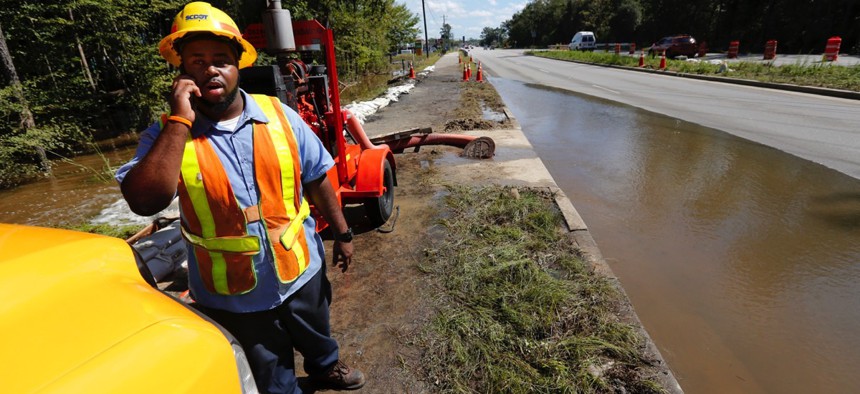Severe Flooding Continues in South Carolina as Waters Rush Toward Coast

George Jenkins, with the South Carolina Department of Transportation, calls to officials asking whether to close Dorchester Road as floodwaters caused by high tide begin to flood the road again at Sawmill Branch Canal in Summerville, S.C., Thursday, Oct. Mic Smith / AP Photo

Connecting state and local government leaders
Officials are having trouble convincing some residents to evacuate in advance of coming floodwaters that may not recede for 12 days, Gov. Nikki Haley says.
As swollen rivers continued to drain from central South Carolina on Thursday toward the Atlantic Ocean, authorities in the state urged residents in several coastal areas to evacuate.
But Gov. Nikki Haley said they were having trouble getting some people to follow that advice.
“The sun is out, but the water is coming,” Haley said at a noontime press conference. “We have thousands of people that won't move,” she added. “We've got to get them to move."
The state’s Department of Public Safety has confirmed that at least 17 people have died in weather-related incidents since South Carolina was hit with record-breaking rainfall late last week. Homes remain underwater, roads and bridges have been damaged, and over a dozen dams have failed. By Wednesday, 16 counties were eligible for federal disaster assistance.
According to Haley, places that face imminent flood risks are around: Georgetown County, located midway between Charleston and Myrtle Beach, on Winyah Bay; Jamestown, which is situated at the southwest corner of Georgetown County, along the Santee River, about 20 miles from the coast; and areas south of Givhans Ferry, west of Charleston, near the Edisto River.
“We have been through the first big wave, we are about to go through the second big wave,” she said.
The governor warned that flooding was expected to start in the vicinity of Georgetown County by around midnight on Thursday, and that areas around Jamestown and Givhans Ferry would likely be inundated within about 72 hours. The waters, she said, might not recede for 12 days.
“That water’s going to stay,” Haley said. “There's no place for it to go."
Later in the afternoon, Georgetown County’s emergency management director, Sam Hodge, issued a video statement specifying three areas within the county that were specifically at risk. These were located near the Black River, the Pee Dee River and Mingo Creek.
“If you live in those areas, and you feel threatened at all by the flood, we ask that you evacuate,” he said. But he added: “We’re not in panic mode.”
Hodge also stressed that “there’s no need to evacuate all of Georgetown County.”
During the course of the flooding, at least 14 dams in the state have failed, according to the South Carolina Department of Health and Environmental Control. These failures varied in terms of severity. Haley said officials are now monitoring 70 dams.
The state has 23 shelters open with 474 occupants, according to the governor. She also said that over 1,200 rescues had been carried out statewide to save both people and animals.
As of Thursday, 38 boil-water advisories remained in place.
The portion of South Carolina that experienced the worst flooding initially was a region in the center of the state known as the Midlands, which includes Columbia, the state capital.
Local agencies and National Guard troops were working on Thursday to temporarily fix a damaged canal in Columbia, in an effort to stabilize water levels in it so that they were sufficient to feed a major municipal water supply facility.
Two other facilities continued to deliver water to city residents at higher than normal levels, and local officials stressed at a press conference on Thursday morning that the municipal water system was not about to run dry.
On Wednesday, the city of Columbia estimated that less than 10,000 utility customers were without water, down from an estimated 42,000 people the prior day.
Farmers in South Carolina were also confronting a heavy toll from the floods. The state’s agriculture commissioner, Hugh E. Weathers, said at the press conference, where Haley spoke on Thursday, that crop losses so far were estimated to be around $300 million. He also said the state was working to file a request for assistance from the U.S. Department of Agriculture.
Describing areas he visited along the Black, Catawba and Pee Dee Rivers earlier in the week, Weathers said he “saw farms that looked like one-thousand acre lakes.”
Bill Lucia is a Reporter for Government Executive’s Route Fifty.

NEXT STORY: A Plan to Ship Water From Alaska to California; In Montana, No Sodium Pentathol, No Executions





